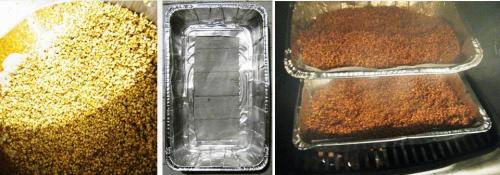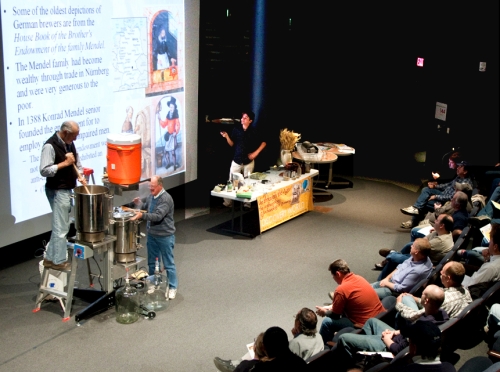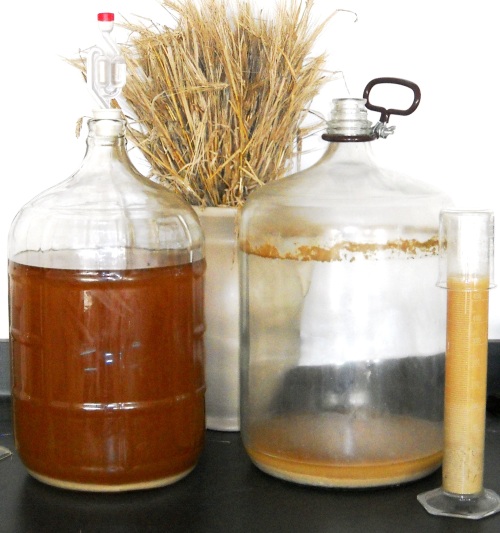The second recipe we brewed during this season’s Ale through the Ages at Discovery World was a traditional Grätzer Ale. There was great crowd on hand to participate in this brewing session to learn about the origins of this enigmatic smoked wheat ale. Grätzer is the German name derived from the town of Grätz, formerly in western Prussia. Today this town is known as Grodzisk, located in the province of Wielkopolski in western Poland. Therefore, this style of smoked wheat ale is known as Grodziskie (Grodzisz) in Polish.
The history of brewing in Western Prussia is quite extensive. For instance, during the 15th Century in the port town of Gdansk on the Baltic Sea, the city’s output of beer was ca. 25 million liters (6.6 million gallons) (ca. 210,000 barrels). Indeed in the year 1416, 378 breweries were in operation (Unger 2004:121). The Posnań district of western Poland also has a deep brewing tradition, most notably as the birth place of Grodziskie smoked wheat ale. In 1890s Poznań (Posen) had 158 breweries, 101 of which were ale breweries producing between them 177,038 hl (148,471 Barrels) (4,676,849.2 US Gallons). The other 57 breweries were lager breweries producing 307,800 hl. (258,134 Barrels) among them. Hence, lager production accounted for 63% of the total output from Posnań, compared to 37% for ale production (Zeitschrift für das gesammte Brauwesen 1894, p.23).
In the town of Grodzisk (Grätz) alone, there were five breweries in operation in 1900. While several styles of beer were being produced in Grodzisk, the most distinct was the Grodziskie smoked wheat ale. Sadly, in 1994 the large Grodziskie Brewery closed when it was bought by local rival Lech Brewery, which ostensibly ended the commercial production of this style of beer in Poland.
According to legend, the popularity of this type of beer is associated with the Benedictine monk Bernard of Wąbrzeźno (1575-1603). After blessing a dried well in Grodzik, it eventually refilled, which allowed brewers to produce their famous Grodziskie smoked beer. Moreover, Jedrzej Kitowicz (1728-1804) wrote in A Description of Manners under Augustus III the following: “Grodzisk was famous and increasingly after the Greater Poland (mid 15th century)…(Grodziskie) is a thin and tasty beer…doctors which prohibit all alcoholic beverages to patients permit drinking Grodziskie beer.”
Traditional Grodziskie is produced by smoking wheat malt with oak or beech wood. This I had to do myself on a grill, as smoked wheat malt is difficult to obtain. I cut out the base of an aluminum foil tray and stapled metal mesh screen to the bottom, in order to allow the smoke to filter through the grain bed. After letting the wheat malt soak in water overnight, it was ready to be placed in the smoker. I used wet oak placed over a low flame to produce a heavy smoke atmosphere in which the wet grain was subjected to for a minimum of three hours.
 Once the smoked wheat malt was dry it was time to grind it and get it ready for brewing. Given the large number of participants in this brewing session, we brewed 10 gallons of Grätzer. This required 20 lbs of wheat malt, 16 lbs of which was oak-smoked. The mash stabilized at 150F for 40minunts before the program began. We sparged the mash with 180F water and brought the wort to a rolling boil. Polish Marinka hops, Hallertau Mittelfruh and German Spalt hops were added throughout the boil. Once the wort was cooled one five gallon carboy was fermented with German Ale/Kolsh yeast from White Labs, while the other was fermented with German Wheat yeast from Wyeast.
Once the smoked wheat malt was dry it was time to grind it and get it ready for brewing. Given the large number of participants in this brewing session, we brewed 10 gallons of Grätzer. This required 20 lbs of wheat malt, 16 lbs of which was oak-smoked. The mash stabilized at 150F for 40minunts before the program began. We sparged the mash with 180F water and brought the wort to a rolling boil. Polish Marinka hops, Hallertau Mittelfruh and German Spalt hops were added throughout the boil. Once the wort was cooled one five gallon carboy was fermented with German Ale/Kolsh yeast from White Labs, while the other was fermented with German Wheat yeast from Wyeast.
 Traditionally isinglass was used in Northern Europe and Britain to accelerate the clarification (fining) of cask-conditioned ales. Isinglass is a fining that is produced from sturgeon bladders, which causes the live yeast to flocculate into a jelly-like mass that settles to the bottom of the cask. For optimum performance, the beer must be fined at the coldest point in the process (ca. 50 F). This was done during during secondary fermentation, at which point the carboy was chilled outside (40-55 F).
Traditionally isinglass was used in Northern Europe and Britain to accelerate the clarification (fining) of cask-conditioned ales. Isinglass is a fining that is produced from sturgeon bladders, which causes the live yeast to flocculate into a jelly-like mass that settles to the bottom of the cask. For optimum performance, the beer must be fined at the coldest point in the process (ca. 50 F). This was done during during secondary fermentation, at which point the carboy was chilled outside (40-55 F).
 The results of this traditional Grätzer are quite pleasing. At 4% ABV this smoked wheat ale slightly hazy with distinct smoky notes and a crisp hop finish.
The results of this traditional Grätzer are quite pleasing. At 4% ABV this smoked wheat ale slightly hazy with distinct smoky notes and a crisp hop finish.
It would be a shame for this ale to fade into the ether like so many other lost styles. Fortunately there a revival may be taking place in Grodzisk Poland. In August of 2010, a home brewing competition was held during the 31st International Breweriana Exchange called, “Almost like Grodzisz.” The goal was to recreate and revive the legendary Grodzisk beer brewing tradition, which was judged by former Grodziskie Brewery workers. Perhaps this is incentive to maintain the longevity of this very old style of ale for generations to come. Na Zdrowie!






It’s a great distinction for me (as a Pole) that sameone is interested in Polish styles/beers, especially those which were forgotten in my country. Quite good article but unfortunatelly there are few misstatements. The original Grodziskie was produced from a 7,7 Blg wort (1.0306 OG). The 14 Blg version was introduced on the market at the end of 80’s and never got as popular as the 7,7. I’ve never tried it, but i’ve heard that Grodziskie 14% was hardly drinkable comparing to the original. After IIWW Grodziskie 7,7 was probably the only beer in Poland that was refermented in a bottle. Production was very fast, wort was cooled to cca 18*C and then had spent about 4-5 days in fermentation vessels with a blend of 2 top-fermenting house yeast strains and 1 bottom-fermenting strain. Next there was an addition of isinglass and the beer was transfered to bottles, without priming sugar. Refermentation was caused by residual sugars so the whole process was hard to control. Grodziskie was often over-saturated and in hot days it could gushed during openning. When i’ve asked people who had drunk 7,7 version about the flavor and apperance, they told me that it was clear with beautiful long-lasting white head. The color was similar to Bohemian Pilsener. Yeasty in aroma and flavor, earthy also nice hop with slighty smoky character. Other attributes could resembled a Kolsch or Bohemian Pils, so I don’t think that Wyeast 3333 are appropriate for this style. The IBUs were propably varing between 25-30 and it depended by year (they used whole hops). For mashing schedule you can look here.
Pingback: Beer History: Lost in Poland, Grodziskie Bubbles Up in the US | Tasty Terminus
Why’d you go with the kolsch yeast? I’ve read that this style may have been soured a bit as well. I’m thinking of using a saison strain on this. What’d ya think?
Pingback: FuzzyBrew | Nate heads to the 2012 Great Taste of the Midwest beer fest in Wisconsin
A georgaphical correction: Grodzisk never had anything to do with West Prussia. You are mixing up two different regions in your introduction.
Grodzisk is a town in the province of Greater Poland (german ‘Grosspolen’), which was the core of early medieaval kingdom of Poland. Following the partitions of Poland at the end of 18th century it become part of kingdom of Prussia as ‘South Prussia’ (and that was the first time anyone ever called it Prussia). Then after the congress of Vienna in 1815 the town become part of autonomous duchy of Poznan (Herzogtum Posen) ruled by the Prussian king.The province then lost its autonomy and became a province of kingdom of Prussia (‘Provinz Posen’).
West Prussia (‘Provinz Westpreussen’) was a different province of that kingdom, located to the north of Posen and containing among others Gdańsk (Danzig) and Toruń (Thorn). What those two provinces had in common was that both were acquired by kingdom of Prussia during the partitons of Poland.
So to refer to Grodzisk as ‘Prussia’ when talking about times prior to the end of 18th century is completely anachronistic, and even after that is a bit misleading, as it was part of Kingdom of Prussia, but never the lands of Prussia proper.
Thank you Cort2 for your geographical correction on Grodzisk…never being part of West Prussia…i humbly stand corrected. The focus however on this brewing demonstration was to illustrate the German Gratzer version of the ale. One more reason to visit the region!
There was not never a German version of Grodziskie. it is an exclusively Polish kind of beer. and it was produced only here in Grodzisk starting from 16th century. Term Graetzer was only used during German occupation of western Poland during Partition in 19th century and during the Nazi time when Hitler conquered Poland. Please use a correct name to our traditional beer.